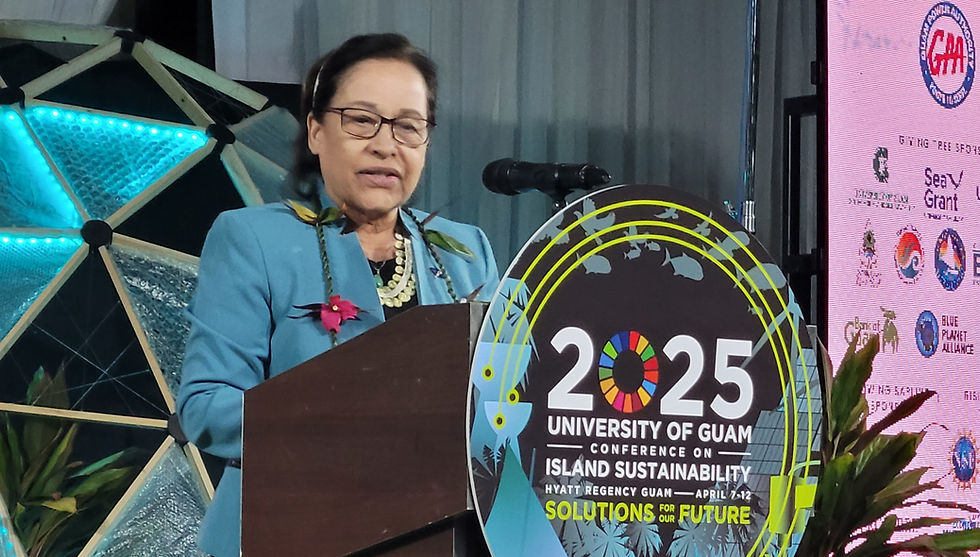'It was just how we used to live:' In the old days, Marshall Islands practiced sustainable living
- Admin

- Jun 5
- 4 min read

By Louella Losinio
Growing up in a small, close-knit community, Hilda Heine, the president of the Marshall Islands, learned early the meaning of sustainability. As one of 10 children and the daughter of a pastor, Heine said her family relied on the land and ocean for their needs.
“We didn't have much in terms of material things, but we were content with what nature provided for the family,” she said, keynoting the 2025 Conference on Island Sustainability in April.
Heine recalled a time when ships from the main island visited the outer islands only twice a year. Her father’s farming skills and her parents' resourcefulness ensured the family always had fresh vegetables, eggs and seafood. “Our reliance on imported goods was minimal, and I do not recall ever wanting, needing or being hungry. Sustainability was not a widely used word back then; it was just how we lived.”
This upbringing instilled in her a respect for the environment and sustainable living, values deeply rooted in Marshallese culture and traditions. “That way of life shaped who I am today and fueled my commitment to a future where we return to balance—not in a nostalgic way but with the benefits of new tools, partnerships, and knowledge,” Heine said.
Today, facing the existential threats of climate change and rising sea levels, she emphasized that while land elevation is crucial, it cannot be the sole focus for the Marshall Islands. Effective adaptation, she argued, requires a balanced approach integrating both hard and soft solutions.
“In the face of climate change and rising sea levels, our nation is not merely trying to survive. We are working hard to be sustainable. We are working hard today so the future generations may thrive,” she said.
Heine outlined the Marshall Islands’ national climate adaptation strategy, emphasizing nature-based solutions such as farm building, revegetation, reef protection and coral restoration. These initiatives enhance ecosystems and provide natural buffers against erosion, fostering biodiversity and long-term sustainability.
“These efforts or approaches reduce erosion, provide natural stone buffers and support biodiversity, all while being cost-effective and sustainable in the long run. To ensure these solutions are well planned and effectively implemented, we rely on strong governance and partnerships,” she said.
Beyond climate adaptation, Heine stressed the importance of ocean health and sustainability for the nation's development, particularly in the fisheries sector. The Marshall Islands is implementing community-based fisheries management, blending traditional knowledge with modern conservation methods to promote sustainable practices.
Heine highlighted a recent collaboration with the Federated States of Micronesia and Papua New Guinea as a significant advancement in fisheries development through the Pacific Island Tuna Tripartite Partnership. The three nations signed the agreement in February, committing to strengthening the tuna industries among the signatory nations. The commitments under the memorandum of agreement included the 100 percent monitoring of licensed fishing vessels and the dockside offloading of tuna catches.
She also noted local policy commitments aimed at balancing economic development with environmental stewardship. “This includes reducing bycatch, preventing illegal fishing, and exploring sustainable aquaculture initiatives. We are especially proud of our recent designation of the first National Marine Sanctuary in the Marshall Islands,” Heine said.
Signed into law on Jan. 8, the sanctuary spans 18,500 square miles of pristine Pacific ecosystems in the northern Marshall Islands, safeguarding marine life such as deep-sea sharks, green turtles, and coral reefs.
Addressing the immediate need to counter coastal hazards and sea-level rise, Heine said the National Adaptation Plan guides the nation’s efforts in addressing climate change impacts, balancing rural resilience with the threats facing their more populated communities.
With limited resources, prioritizing which atolls and communities to fortify or elevate is crucial, she said. Securing fine and large aggregates for infrastructure development, from shoreline fortification to land elevation, is a significant challenge. The Marshall Islands is exploring more sustainable aggregate sourcing methods, exemplified by a World Bank-funded study near the urban centers of Majuro and Ebeye.
The World Bank-funded resilience project used light detection and ranging technology to survey the Majuro and Ebeye lagoons, identifying suitable aggregate sources. Heine noted that small island atoll nations have limited options, primarily river blasting or lagoon sediment extraction. Studies suggest lagoon sediment extraction is preferable, offering a resource for land reclamation and elevation.
While a modest solution, she said the lagoon aggregate project could yield enough material to raise approximately one-third of the islands' area by three meters. Heine illustrated the current difficulties by mentioning that boulders for a seawall project on Ebeye had to be imported from as far away as Dubai. “So that's telling you how hard it is to secure these kinds of aggregates,” she remarked.
The nation is also committed to finding more sustainable excavation techniques, such as cutter suction dredging, which can access identified aggregate sources while phasing out unsustainable shoreline dredging practices.
For the Marshallese people, Heine emphasized the deep connection between their culture and the land, as well as their traditional systems. “When we lose our land, we risk losing our lineage, our history, and the social structures that hold our communities together,” she said. “It puts at risk both our tangible and intangible heritage: our sacred sites, our oral histories, and the traditional knowledge and materials that define who we are.”
Subscribe to
our digital
monthly edition








